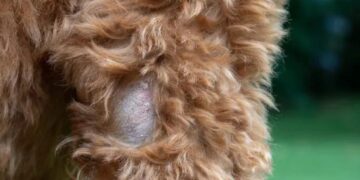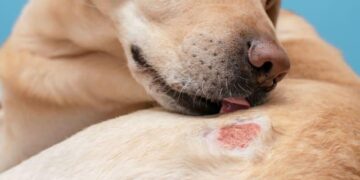Table of Contents
My name is Alex, and for most of my life, I believed my love for dogs was a tragic, unrequited affair.
It wasn’t for lack of trying.
From my earliest memories, I was the kid who would brave the inevitable itchy eyes and wheezing chest just for a few precious minutes with a neighborhood Golden Retriever.
My body, however, had drawn a clear line.
My allergy to dogs wasn’t just a case of the sniffles; it was a full-blown immune system revolt, complete with nasal congestion that felt like a permanent head cold, facial pressure, and asthma that could turn a joyful moment into a frightening struggle for breath.1
Years of allergist visits and a pharmacy’s worth of antihistamines led me to the same conclusion as every well-meaning friend and family member: if I ever wanted a dog, it had to be a “hypoallergenic” one.
The term itself felt like a golden ticket.
It was the solution, the one-word answer to a lifetime of longing.
So, I did my homework.
I spent months researching, reading every list, and cross-referencing every breed characteristic.
I settled on a beautiful Soft Coated Wheaten Terrier puppy I named Finn.
He was perfect—a breed celebrated for its low-shedding, silky coat, a supposed godsend for allergy sufferers.2
I followed every piece of standard advice.
I bought the best air purifier, vacuumed daily, and washed his bedding constantly.
For the first week, it felt like a dream.
Then, the dream began to fray.
A persistent tickle in my throat became a hacking cough.
The stuffy nose returned with a vengeance, making sleep a nightly battle.4
I’d wake up with swollen, blue-colored skin under my eyes, a tell-tale sign of chronic allergic inflammation.1
I was taking the maximum dose of my allergy medication, but it was like trying to bail out a sinking boat with a teaspoon.
The worst part was the guilt.
I loved this little creature who followed me from room to room, but my own home had become a source of misery.
The breaking point came one night when a severe asthma attack left me gasping for air, terrified, and utterly defeated.5
The decision to return Finn was one of the most heartbreaking moments of my life.
It felt like a profound personal failure.
I had followed the blueprint, bought the “right” dog, and it had all fallen apart.
I was left to conclude that my allergy was simply too severe, that a life with a dog was a door that was permanently closed to me.
Part I: The Flawed Blueprint – Why the Search for a “Hypoallergenic” Dog Is a Trap
In the quiet, dog-less weeks that followed, I fell into a rabbit hole of research, driven by a desperate need to understand why the “guaranteed” solution had failed so spectacularly.
My search led me far beyond pet-care blogs and into the seemingly unrelated world of architectural acoustics and sound engineering.
It was there, while reading about how professional recording studios are built, that I had my epiphany.
The Epiphany in the Echo Chamber
An acoustical engineer explained that you can’t soundproof a room by simply placing a small square of “sound-absorbing” foam on a wall.
The sound—the noise—doesn’t just hit that one spot.
It travels through the air, bounces off every surface, and seeps through the tiniest cracks in the walls, floors, and doors.6
To achieve true silence, you need a complete system: you need to add heavy, dense
mass to the walls to block the sound’s energy; you need to meticulously seal every gap and crack to prevent leaks; and you need to decouple the walls from the building’s structure to stop vibrations from traveling through.8
Suddenly, my entire struggle with Finn clicked into place.
I had been treating my dog allergy like that single, useless piece of acoustic foam.
I had put all my faith in one component—the “hypoallergenic” dog—believing it alone could solve the problem.
But the allergens, like sound, weren’t coming from just one place.
They were airborne, sticking to every surface, and seeping into every corner of my life.
My approach was doomed from the start because it focused exclusively on the source of the “noise” (the dog breed) while completely ignoring the pathways it traveled (my home environment) and my own sensitivity to it (my personal allergic threshold).
I didn’t need a mythical “silent” dog; I needed to soundproof my life.
This realization was a paradigm shift.
It transformed me from a passive victim of my allergies into an active architect of my own solution.
It was the beginning of a new journey, one based not on myths, but on a systematic, scientific approach to building a life where a dog and I could coexist peacefully.
Deconstructing the “Noise”: The Uncomfortable Truth About Dog Allergens
The first step in building this system was to truly understand the “noise” I was trying to block.
The widespread belief, the one I had clung to, is that dog allergies are caused by fur.
This is a fundamental misunderstanding.
The real culprits are specific proteins produced by all dogs.9
These allergens are found primarily in a dog’s dander (the microscopic flakes of dead skin they shed), saliva, and urine.1
The science has even identified the primary offenders.
The major dog allergen is a protein called Can f 1, which is produced in a dog’s tongue tissue and is found in their saliva and dander.10
There are others, too, like
Can f 2, Can f 3 (a serum albumin), and Can f 5 (found specifically in the urine of male dogs).10
These proteins are the true source of the “noise.” When a dog licks its coat, the saliva dries, and the allergen-coated dander flakes off.
These particles are microscopic, jagged, and incredibly lightweight, allowing them to remain airborne for hours and travel throughout your home with the slightest air current.1
They stick to furniture, carpets, bedding, and clothes, creating a persistent reservoir of allergens that can linger for months, even after a pet is gone.12
This is the critical reason why no dog is 100% hypoallergenic.14
Even a completely hairless dog, like the Xoloitzcuintli, still has skin, saliva, and urine, and therefore still produces the proteins that cause allergies.9
The term “hypoallergenic” is largely a marketing concept that has been co-opted to mean “low-shedding.” While a low-shedding coat can be a helpful piece of the puzzle, it is far from the whole solution.
In fact, some objective scientific studies have completely dismantled the idea that certain breeds are inherently “safer.” One study cited by Cleveland Clinic found that the levels of the main dog allergen in homes with “hypoallergenic” breeds were no different from those in homes with other breeds.16
Shockingly, another analysis found that the allergen levels were actually
higher in the hair and coat samples from the supposedly hypoallergenic dogs.16
This leads to a crucial understanding that I call the “Personalization Paradox.” The very idea of a universally safe breed is a myth because allergen production is highly individual.
Research and anecdotal evidence strongly suggest that allergen levels can vary more between two individual dogs of the same breed than between different breeds on average.17
This means a person could have a severe allergic reaction to one Poodle and live completely symptom-free with another Poodle from a different line.17
This paradox explains why one person’s success story with a specific breed is no guarantee of another’s.
It shatters the simplistic “best breeds” list and forces us to adopt a more nuanced, systems-based approach that accounts for the specific dog, the specific person, and their shared environment.
Part II: The Soundproofing Solution – A Systems-Based Guide to Allergy Management
Armed with this new understanding, I began to design my “allergen soundproofing” system.
It’s not a single product or a magic bullet.
It’s a multi-layered strategy, where each layer builds upon the last to systematically reduce the total allergen load in my life.
It’s about blocking the noise, sealing the leaks, and absorbing the reverberations until the ambient level is low enough for my body to tolerate.
Layer 1: Adding Mass – Choosing a Low-Resonance Dog
In acoustics, the first line of defense against sound is Mass. A thick, dense concrete wall blocks far more sound than a thin, flimsy one.6
In my allergy system, the “mass” is the dog itself.
The goal is not to find a silent, allergen-free dog (which doesn’t exist), but to choose a “low-resonance” dog—one whose physical traits make it easier to manage the allergens it inevitably produces.
This reframes the entire process of breed selection.
Instead of searching for a “hypoallergenic” label, we should be looking for specific, tangible characteristics.
The most important of these is a predictable, non-shedding coat.16
Breeds with curly, wiry, or continuously growing single-layer coats are generally better choices, not because they are allergen-free, but because their coat structure is more effective at
trapping dander and saliva-coated hair, preventing it from becoming airborne and contaminating the entire house.17
Think of it as a built-in containment system.
This is the scientific principle behind why breeds like Poodles, Portuguese Water Dogs, and Schnauzers are so frequently recommended.
It’s not magic; it’s mechanics.
However, as the Personalization Paradox shows us, a breed is only a starting point.
It is essential to spend significant time with the specific dog you plan to bring home before making a final decision.18
To help navigate this first crucial layer, I’ve compiled a compendium of breeds that generally fit the “low-resonance” profile.
This is not a list of “safe” dogs.
It is a tool for evaluating the “mass” component of your soundproofing system, helping you find a dog whose physical makeup gives you a strategic advantage in the fight against allergens.
| Breed | Size | Coat Type | Grooming Needs | Energy Level | Temperament | Allergen Profile Notes |
| Poodle (All sizes) | Toy, Miniature, Standard | Curly, dense single coat | High; requires professional grooming every 4-6 weeks to prevent matting. | High | Intelligent, proud, active | The quintessential “low-shed” coat is excellent at trapping dander. However, their high intelligence and energy require significant engagement, which means close contact. 3 |
| Bichon Frise | Small | Soft, curly double coat | High; daily brushing is essential to prevent mats. Professional grooming is needed regularly. | Medium | Playful, curious, charming | The puffy coat produces very little dander and sheds minimally. Their small size means a smaller total surface area for allergen production. 3 |
| Portuguese Water Dog | Medium | Tightly curled or wavy single coat | Moderate; requires regular brushing (2-3 times/week) and trimming. | High | Intelligent, athletic, eager to please | Bred for water work, their coat is waterproof and low-shedding. They are highly active and thrive on “jobs,” making them great for active families. 3 |
| Schnauzer (All sizes) | Miniature, Standard, Giant | Wiry, dense double coat | Moderate; requires regular brushing and professional “hand-stripping” or clipping to maintain texture and health. | Medium-High | Smart, fearless, spirited | The harsh, wiry topcoat sheds very little. Their characteristic beard and furnishings can trap saliva and food, requiring regular cleaning. 3 |
| Soft Coated Wheaten Terrier | Medium | Silky, soft, wavy single coat | High; needs daily grooming to prevent mats from forming in their soft coat. | High | Friendly, happy, deeply devoted | The low-shedding coat is a major plus. They are known for their exuberant “Wheaten Greetin’,” which can involve jumping and licking, increasing saliva exposure. 3 |
| Maltese | Toy | Long, silky single coat | High; requires daily brushing and regular professional grooming to prevent tangles and mats. | Medium | Gentle, playful, charming | A classic low-shedding lap dog. Their small size is a significant advantage in minimizing the overall allergen load in a home. 3 |
| Lagotto Romagnolo | Medium | Woolly, dense, curly coat | Moderate; coat is water-repellent and requires regular trimming but sheds minimally. | Medium-High | Affectionate, keen, undemanding | Italy’s “truffle dog” has a Poodle-like coat that effectively traps dander. They are generally eager to please and trainable. 2 |
| Irish Water Spaniel | Large | Dense, crisp curls | Moderate; requires brushing every few weeks to remove debris and prevent matting. | High | Playful, hardworking, alert | The tallest of the spaniels, their water-repellent double coat is a tight mass of curls that sheds very little. They are clowns at heart but require a lot of exercise. 3 |
| Bedlington Terrier | Medium | Crisp, curly coat | Moderate; requires weekly brushing and professional clipping every couple of months. | Medium | Gentle, charming, alert watchdog | Their unique “lamb-like” coat is a mix of hard and soft hair that is low-shedding. They are generally calm for a terrier but still need daily walks. 3 |
| Afghan Hound | Large | Long, thick, silky coat | Very High; requires hours of brushing each week to prevent tangles and mats. | Medium | Dignified, aloof, sweet | It’s counter-intuitive, but their long, human-like hair grows continuously and doesn’t shed much. The grooming commitment is immense. 14 |
| Chinese Crested | Toy | Hairless or “Powderpuff” (coated) | Low (Hairless) to Moderate (Powderpuff) | Medium | Lively, alert, affectionate | The hairless variety has minimal hair to shed, but they still produce dander from their skin, which requires regular care (lotion, sunblock). Powderpuffs have a soft coat that needs brushing. 3 |
| Xoloitzcuintli | Toy, Miniature, Standard | Hairless or coated | Low (Hairless) to Moderate (Coated) | Medium | Calm, loyal, attentive | Like the Crested, the hairless variety minimizes shed hair but still produces skin dander. They are an ancient and hardy breed. 3 |
| Kerry Blue Terrier | Medium | Soft, dense, wavy coat | High; needs to be brushed thoroughly several times a week and trimmed monthly. | High | Smart, alert, people-oriented | Their beautiful blue-gray coat is non-shedding and soft. Like all terriers, they have a spirited nature and need consistent training and exercise. 3 |
| Coton de Tulear | Small | Long, soft, cotton-like coat | High; requires daily brushing to maintain its signature texture and prevent mats. | Medium | Charming, bright, happy-go-lucky | The “Royal Dog of Madagascar” has a profuse coat that sheds very little. They are bred as companions and thrive on being with their people. 3 |
| Barbet | Medium-Large | Long, woolly, curly coat | High; requires regular, thorough brushing to prevent matting, especially if they get wet. | Medium-High | Joyful, smart, loyal | A French water dog with a thick, protective coat. Their name comes from the French word for “beard” (barbe), which, like a Schnauzer’s, can trap saliva. 2 |
Layer 2: Sealing the Gaps – Fortifying Your Home Environment
In soundproofing, even after building a massive wall, the job is only half done.
Sound is like water; it will find the path of least resistance and leak through the smallest opening.
The “1% Rule” in acoustics is a stark reminder of this: a 1% opening in a wall can allow up to 50% of sound to pass through.7
Allergens behave in exactly the same Way. Having a low-shedding dog is a great start, but if your house is full of allergen “leaks,” you will still be overwhelmed.
This layer is about meticulously sealing those gaps.
This involves a strategic and sometimes ruthless approach to environmental control.
The goal is to systematically remove the reservoirs where allergens collect and to purify the pathways through which they travel.
This is not about just “cleaning more”; it’s about re-engineering your living space to be inhospitable to allergens.
Creating the “Airlock”: The Bedroom Sanctuary
The single most powerful environmental change you can make is to declare the bedroom a 100% pet-free zone.22 You spend a third of your life in this room, and making it an allergen-free sanctuary gives your immune system a crucial 8-hour recovery period every single night.
This allows your “allergy bucket” to empty, making you more resilient to exposures during the day.
To make this effective, it must be an absolute rule.
Keep the door closed at all times.13
Encase your mattress, box spring, and pillows in dust-proof, allergen-impermeable covers.24
Wash all bedding in hot water (at least 130°F or 54°C) weekly.24
This space must become your clean room, your nightly reset button.
Systematic Decontamination of Your Home
Beyond the bedroom, the rest of your home needs to be fortified.
- Purify the Air: Invest in high-quality HEPA (High-Efficiency Particulate Air) purifiers and place them in the rooms where you and the dog spend the most time, especially the main living area.10 These devices are critical for capturing the microscopic dander particles that remain suspended in the air.25 Change the filters in your HVAC system frequently, using high-rated electrostatic filters.26
- Eliminate Reservoirs: Carpet is the single biggest allergen reservoir in a home. If at all possible, replace wall-to-wall carpeting with hard-surface flooring like hardwood, tile, or vinyl.23 If you must have rugs, use low-pile options that can be washed regularly in hot water. The same principle applies to other fabrics. Limit heavy drapes, upholstered furniture, and throw pillows. Opt for leather or tightly woven, washable fabrics, and consider using washable covers on couches and chairs.23
- Implement a Rigorous Cleaning Protocol: This is a non-negotiable part of the system. Vacuum frequently (multiple times a week) with a vacuum that has a sealed system and a HEPA filter to prevent allergens from being blown back into the air.10 Damp-mop hard floors and wipe down all hard surfaces, including walls and baseboards, with a damp cloth regularly to capture settled dust and dander.13
It is also crucial to recognize that dog allergens are not the only “noise” in your environment.
The concept of the “Allergen Threshold” or “Allergy Bucket” is key here.27
Imagine your tolerance for allergens is a bucket.
Every allergen you’re exposed to—pollen, dust mites, mold, certain foods—adds a little bit of water to that bucket.
Your symptoms only appear when the bucket overflows.27
This means that successfully living with a dog isn’t just about managing dog allergens; it’s about strategically reducing the
total amount of water going into your bucket from all sources.
By aggressively controlling dust mites with allergen-proof bedding, keeping windows closed during high pollen season, and preventing mold growth in bathrooms, you lower the baseline water level in your bucket.24
This creates more capacity, more “room,” to tolerate the allergens from your dog before the bucket overflows.
Every act of general allergen control is a direct investment in your ability to live happily with your P.T.
Layer 3: Decoupling & Absorption – Proactive Pet and Personal Care
The final layer of our soundproofing system involves active interventions that “absorb” the noise at its source and “decouple” you from its effects.
This is about proactive care for both your dog and yourself to reduce allergen production and increase your personal tolerance.
This creates a powerful feedback loop: a healthier, well-cared-for dog produces fewer allergens, and a healthier, well-supported human has a more resilient immune system.
This is the Symbiotic Health Loop.
The health of the dog and the health of the allergic owner are not separate issues; they are fundamentally intertwined.
Every step you take to improve your dog’s skin and coat health is a direct measure to improve your own respiratory health.
Every step you take to support your immune system gives you more latitude to enjoy life with your dog.
Pet-Centric Absorption: Reducing Allergen Output
- Consistent Bathing: This is one of the most effective active measures. Studies have shown that washing a dog can reduce recoverable allergen levels, but the effect is temporary. To be effective, bathing needs to happen consistently, at least once or twice a week.25 It’s crucial to use a high-quality, vet-recommended shampoo that won’t strip the natural oils from your pet’s skin, as dry, irritated skin can actually lead to more dander.23
- Strategic Grooming: Brush your dog frequently—ideally daily—to remove loose hair and dander before it has a chance to enter the environment. Whenever possible, this should be done outdoors by someone who is not allergic.23
- Post-Walk Wipedowns: Keep a container of pet-friendly, hypoallergenic wipes by the door. After every walk, wipe down your dog’s paws, underbelly, and coat. This simple act removes pollen, dust, and other environmental allergens that your dog would otherwise track into your fortified home.13
- Holistic Health and Diet: A dog’s skin and coat health is a direct reflection of their internal health. A diet rich in Omega-3 fatty acids (found in sources like fish oil or green-lipped mussels) has been shown to reduce inflammation and support a healthy skin barrier, which can lead to less shedding and dander.31 Probiotics can also support gut health, which plays a major role in regulating the immune system and can help alleviate inflammatory responses.31
Human-Centric Absorption: Increasing Allergen Tolerance
- Partner with an Allergist: This is not a journey to take alone. An allergist can confirm that you are, in fact, allergic to dogs and not something else. They can also provide a personalized medical toolkit, which may include modern antihistamines, nasal steroid sprays, and, most importantly, immunotherapy (“allergy shots”).33 Immunotherapy is a long-term treatment that involves exposing your body to gradually increasing doses of the allergen, which can desensitize your immune system over time and provide lasting relief.33
- Holistic and Nutritional Support: Just as with your dog, your own health can be bolstered. Certain natural compounds and herbs may help modulate your body’s histamine response. Quercetin, a bioflavonoid found in many plants, has shown anti-inflammatory and antihistamine properties.30 Stinging nettle has also been used traditionally to help reduce the amount of histamine the body produces in response to an allergen.30 As always, it is essential to consult with your doctor or a qualified practitioner before starting any new supplement regimen.
- Personal Hygiene: Simple habits can make a big difference. Wash your hands thoroughly with soap and water immediately after petting or playing with your dog.23 Avoid touching your face, especially your eyes and nose, after contact.4 Consider having a dedicated set of “dog clothes” that you wear for cuddling and playtime to keep your other clothes free of dander.23
Conclusion: The Sound of Silence – My Life Now
Two years ago, I stood in my silent, sterile apartment, the faint scent of puppy shampoo a ghostly reminder of a failed dream.
Today, as I write this, a 14-pound Miniature Schnauzer named Gus is asleep on a washable bed at my feet.
My air purifier hums quietly in the corner.
My eyes don’t itch.
My chest is clear.
The only sound is the gentle rhythm of his breathing.
Bringing Gus home was different.
I didn’t search for a label; I built a system.
I chose a “low-resonance” breed with a wiry coat that I could manage.
I spent weeks “soundproofing” my apartment, turning my bedroom into a fortress of solitude and replacing my old rug with cork flooring.
I committed to a rigorous schedule of cleaning, bathing, and grooming.
I worked with my allergist on a long-term immunotherapy plan.
Each action was a brick in the wall, a seal in the gap, a layer of mass against the noise.
It wasn’t easy, and it requires ongoing diligence.
But the result is a life I truly believed was impossible for me.
The constant, grating “noise” of my allergies has been replaced by the quiet, profound joy of a dog’s companionship.
The heartbreaking truth is that there is no magic dog that will solve your allergies.
The empowering truth is that you don’t need one.
The problem isn’t a lack of hypoallergenic dogs; it’s the flawed blueprint we’ve all been given.
Stop searching for a mythical creature.
Instead, become the architect of your own solution.
Design your system, build your layers of protection, and you may find that the life you’ve been dreaming of is not only possible, but waiting for you on the other side of a well-soundproofed door.
Works cited
- Pet allergy – Symptoms & causes – Mayo Clinic, accessed August 14, 2025, https://www.mayoclinic.org/diseases-conditions/pet-allergy/symptoms-causes/syc-20352192
- 30 ‘Hypoallergenic’ Dogs That Don’t Shed a Lot | PetMD, accessed August 14, 2025, https://www.petmd.com/dog/general-health/hypoallergenic-dogs
- Hypoallergenic Dogs: Breeds for People with Allergies – American Kennel Club, accessed August 14, 2025, https://www.akc.org/press-releases/hypoallergenic-2014-oct/
- Redditors who have dogs while being allergic to them, what is your …, accessed August 14, 2025, https://www.reddit.com/r/dogs/comments/uqv2hq/redditors_who_have_dogs_while_being_allergic_to/
- Pet Allergies Nearly Killed Me And Put Me On Disability | Asthma.net, accessed August 14, 2025, https://asthma.net/stories/pet-allergies-nearly-killed-put-disability
- How to Soundproof: Acoustic Foam Does Not Block Sound, accessed August 14, 2025, https://acousticalsolutions.com/how-to-soundproof-acoustic-foam-does-not-block-sound/
- Mass loaded vinyl noise reduction? : r/soundproof – Reddit, accessed August 14, 2025, https://www.reddit.com/r/soundproof/comments/vzcevx/mass_loaded_vinyl_noise_reduction/
- 8 Soundproofing Ideas to Significantly Improve Acoustics in the Commercial Space and at Home, accessed August 14, 2025, https://acousticalsolutions.com/soundproofing-ideas/
- The Truth about Pet Allergies – To the Point, accessed August 14, 2025, https://www.aaaai.org/Aaaai/media/MediaLibrary/PDF%20Documents/Libraries/EL-allergies-pets-patient.pdf
- Understanding Dog Allergens: A Scientific Overview – Pacagen, accessed August 14, 2025, https://pacagen.com/blogs/dog-allergies/understanding-dog-allergens
- Pet Dander | American Lung Association, accessed August 14, 2025, https://www.lung.org/clean-air/indoor-air/indoor-air-pollutants/pet-dander
- www.niehs.nih.gov, accessed August 14, 2025, https://www.niehs.nih.gov/health/topics/agents/allergens/pets#:~:text=Dog%20allergens%20are%20also%20present,carpets%20and%20furniture%20for%20months.
- Allergic to Your Pet? Learn About Dog and Cat Allergies, accessed August 14, 2025, https://aafa.org/allergies/types-of-allergies/pet-dog-cat-allergies/
- What Dogs Are Hypoallergenic in Crown Point, IN? – Coyne Veterinary Center, accessed August 14, 2025, https://coynevetcare.com/blog/hypoallergenic-dogs-crown-point-in/
- Hypoallergenic Dogs – American Kennel Club, accessed August 14, 2025, https://www.akc.org/dog-breeds/hypoallergenic-dogs/
- Are Any Dog Breeds Hypoallergenic? – Cleveland Clinic Health Essentials, accessed August 14, 2025, https://health.clevelandclinic.org/are-any-dogs-hypoallergenic
- Hypoallergenic Dog Breeds: Is There Such a Thing? | VCA Animal …, accessed August 14, 2025, https://vcahospitals.com/know-your-pet/hypoallergenic-dog-breeds-is-there-such-a-thing
- 47 Hypoallergenic Dog Breeds – MetLife Pet Insurance, accessed August 14, 2025, https://www.metlifepetinsurance.com/blog/breed-spotlights/hypoallergenic-dogs-breeds-good-for-people-with-allergies/
- 35 Hypoallergenic Dog Breeds for Anyone With Allergies – The Spruce Pets, accessed August 14, 2025, https://www.thesprucepets.com/hypoallergenic-dog-breeds-5181208
- Hypoallergenic Dogs – Page 2 of 3 – American Kennel Club, accessed August 14, 2025, https://www.akc.org/dog-breeds/hypoallergenic-dogs/page/2/
- Dogs Breeds That Don’t Shed: 19 Best Breeds for Allergy Sufferers – American Kennel Club, accessed August 14, 2025, https://www.akc.org/press-releases/no-shed-2014-oct/
- I’m allergic to my pet but don’t want to get rid of them, what should I do? – ACAAI Patient, accessed August 14, 2025, https://acaai.org/resource/im-allergic-to-my-pet-but-dont-want-to-get-rid-of-them-what-should-i-do/
- Are You Allergic to Your Pet? | ASPCA, accessed August 14, 2025, https://www.aspca.org/pet-care/general-pet-care/are-you-allergic-your-pet
- Environmental Allergy Avoidance – ACAAI Patient, accessed August 14, 2025, https://acaai.org/allergies/management-treatment/living-with-allergies/environmental-allergy-avoidance/
- Indoor Environmental Interventions for Furry Pet Allergens, Pest Allergens, and Mold: Looking to the Future – PubMed Central, accessed August 14, 2025, https://pmc.ncbi.nlm.nih.gov/articles/PMC5763515/
- Dust Mite Allergies in Dogs and Cats – MedVet Blog, accessed August 14, 2025, https://www.medvet.com/house-dust-mite-allergies-in-dogs-and-cats/
- The Allergy Threshold | Nextmune Laboratories UK, accessed August 14, 2025, https://nextmunelaboratories.co.uk/news/the-allergy-threshold-2/
- What is Allergen Load? | Achoo! Blog, accessed August 14, 2025, https://www.achooallergy.com/blog/learning/what-is-allergen-load/
- Control Indoor Allergens to Improve Indoor Air Quality – Asthma and Allergy Foundation of America | AAFA, accessed August 14, 2025, https://aafa.org/allergies/prevent-allergies/control-indoor-allergens/
- A Holistic Approach to Your Dog’s Allergies – Thriving Canine, accessed August 14, 2025, https://www.thrivingcanine.com/blog/holistic_approach_dog_allergies/
- Holistic Treatment for Dogs with Allergies – Nikolaus Nature, accessed August 14, 2025, https://nikolausnature.com/blogs/dog-health/holistic-treatment-for-dogs-with-allergies
- Holistic Treatments for Dogs with Allergies: Types and When To Use | PetMD, accessed August 14, 2025, https://www.petmd.com/dog/general-health/holistic-treatments-for-dogs-with-allergies
- How to live with allergies and pets | Humane World for Animals, accessed August 14, 2025, https://www.humaneworld.org/en/resources/how-live-allergies-and-pets
- Allergies in Dogs | VCA Animal Hospitals, accessed August 14, 2025, https://vcahospitals.com/know-your-pet/allergy-general-in-dogs






